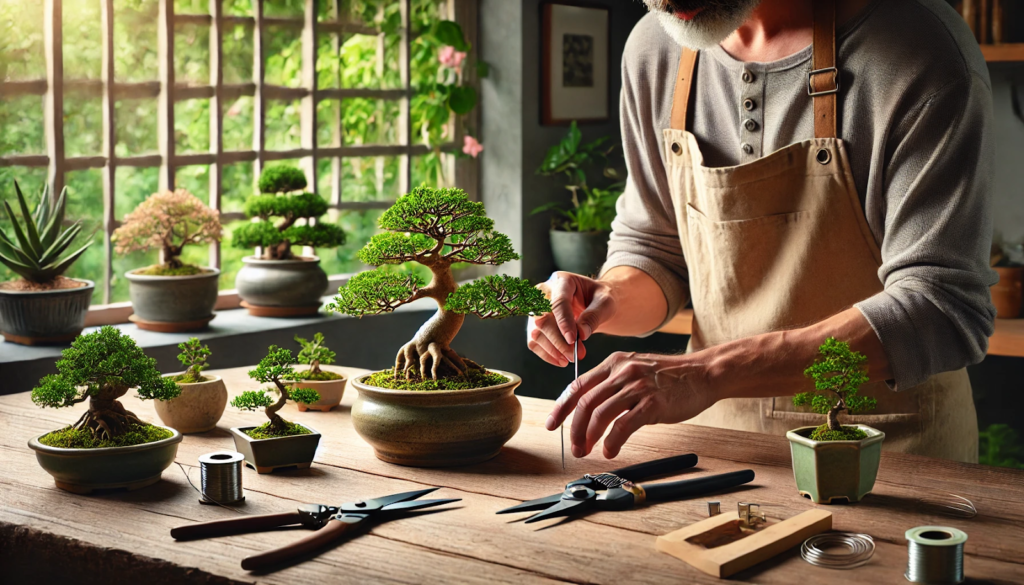Bonsai is more than just a plant—it’s a living art form. Growing a bonsai tree at home brings beauty, mindfulness, and a deep connection with nature into your space. While it may look complex, anyone can start growing bonsai with the right tools, techniques, and patience.
In this guide, you’ll learn the basics of bonsai care and how to start your own miniature tree from scratch.
1. What Is a Bonsai Tree?
Bonsai (Japanese: “tray planting”) is the art of growing trees in miniature form through pruning, shaping, and container cultivation. It’s not a species but a technique applied to regular trees or shrubs.
Purpose:
- Create the appearance of a mature, full-sized tree in miniature
- Reflect harmony between plant, pot, and environment
- Practice patience and mindfulness in care
Bonsai trees can live for decades—or even centuries—with proper care.
2. Best Trees for Bonsai Beginners
Choose hardy, slow-growing species that respond well to shaping.
Indoor Bonsai:
- Ficus (Ficus retusa or Ficus benjamina)
- Jade Plant (Crassula ovata)
- Schefflera (Umbrella Tree)
- Chinese Elm (Ulmus parvifolia)
Outdoor Bonsai:
- Juniper (Juniperus spp.)
- Maple (Acer palmatum)
- Pine (Pinus spp.)
- Azalea (Rhododendron spp.)
Start with a young tree or a bonsai starter kit from a nursery.
3. Essential Bonsai Tools
- Bonsai scissors or shears
- Pruning shears
- Wire cutters
- Bonsai training wire (aluminum or copper)
- Root rake
- Tweezers
- Shallow bonsai pots
- Soil mix with good drainage
Invest in quality tools for better precision and control.
4. Steps to Start Growing a Bonsai Tree
Step 1: Choose Your Tree
Pick a species suited to your climate and indoor/outdoor location.
Step 2: Choose a Bonsai Style
Popular bonsai styles include:
- Formal upright (Chokkan)
- Informal upright (Moyogi)
- Slanting (Shakan)
- Cascade (Kengai)
- Windswept (Fukinagashi)
Each style mimics how trees grow in nature.
Step 3: Prune and Shape
Use scissors to trim excess branches and leaves. Remove inward-growing or overly thick branches.
Step 4: Wire for Structure
Wrap training wire around branches to bend and position them. Remove wire after a few months to avoid scarring.
Step 5: Pot and Position
Choose a shallow pot with drainage holes. Secure the tree, add soil, and gently water.
5. Soil, Water, and Light Needs
Soil:
Use well-draining bonsai soil—typically a mix of akadama, pumice, and lava rock.
Watering:
- Water thoroughly when the soil starts to feel dry
- Avoid letting roots sit in water
- Adjust frequency based on species and season
Lighting:
- Indoor bonsai need bright, indirect light
- Outdoor bonsai may require partial sun to full sun, depending on species
Rotate your bonsai weekly for even growth.
6. Seasonal Care Tips
- Spring: Repot, prune new growth, and fertilize
- Summer: Monitor water and protect from intense heat
- Autumn: Reduce feeding, prepare for dormancy
- Winter: Indoor bonsai need warmth; outdoor species may go dormant
Use organic bonsai fertilizer every 2–4 weeks during active growth.
7. Repotting and Root Pruning
Bonsai trees must be repotted every 1–3 years to avoid root-bound conditions.
How To:
- Remove the tree and gently shake off soil
- Trim about 1/3 of the roots
- Replace with fresh bonsai soil
- Water thoroughly and keep in shade for a few days
Repot in early spring for best recovery.
8. Common Bonsai Problems to Avoid
- Overwatering: Leads to root rot
- Underwatering: Causes leaf drop and dry soil
- Poor lighting: Results in weak or leggy growth
- Wiring too tightly: Damages bark and branches
- Neglecting pruning: Loses shape and structure
Stay consistent and observant to keep your bonsai healthy.
Conclusion: Cultivate Patience, Beauty, and Balance
Growing a bonsai tree is more than gardening—it’s a living meditation. With care, creativity, and time, you can sculpt nature into miniature elegance that evolves with you. Whether on a windowsill or garden bench, your bonsai will reward you with quiet growth and timeless beauty.
Start small, stay curious, and enjoy the journey of bonsai.






